HNBS 312 Organisational Behaviour Report: M&S Analysis
VerifiedAdded on 2023/01/04
|13
|3847
|54
Report
AI Summary
This report provides a detailed analysis of organisational behaviour within the context of Marks & Spencer (M&S). It begins by examining the influence of organisational culture, politics, and power on team behaviour and performance, highlighting the Handy culture model and the impact of these factors. The report then delves into motivation theories, including Herzberg's and Vroom's theories, and explores various motivation techniques employed by M&S. A comparison between effective and ineffective teams is presented, along with an overview of Tuckman's team development theory. The report concludes by analysing key concepts and philosophies of organisational behaviour at M&S, offering insights into how these elements contribute to the company's overall performance and success in the retail industry.
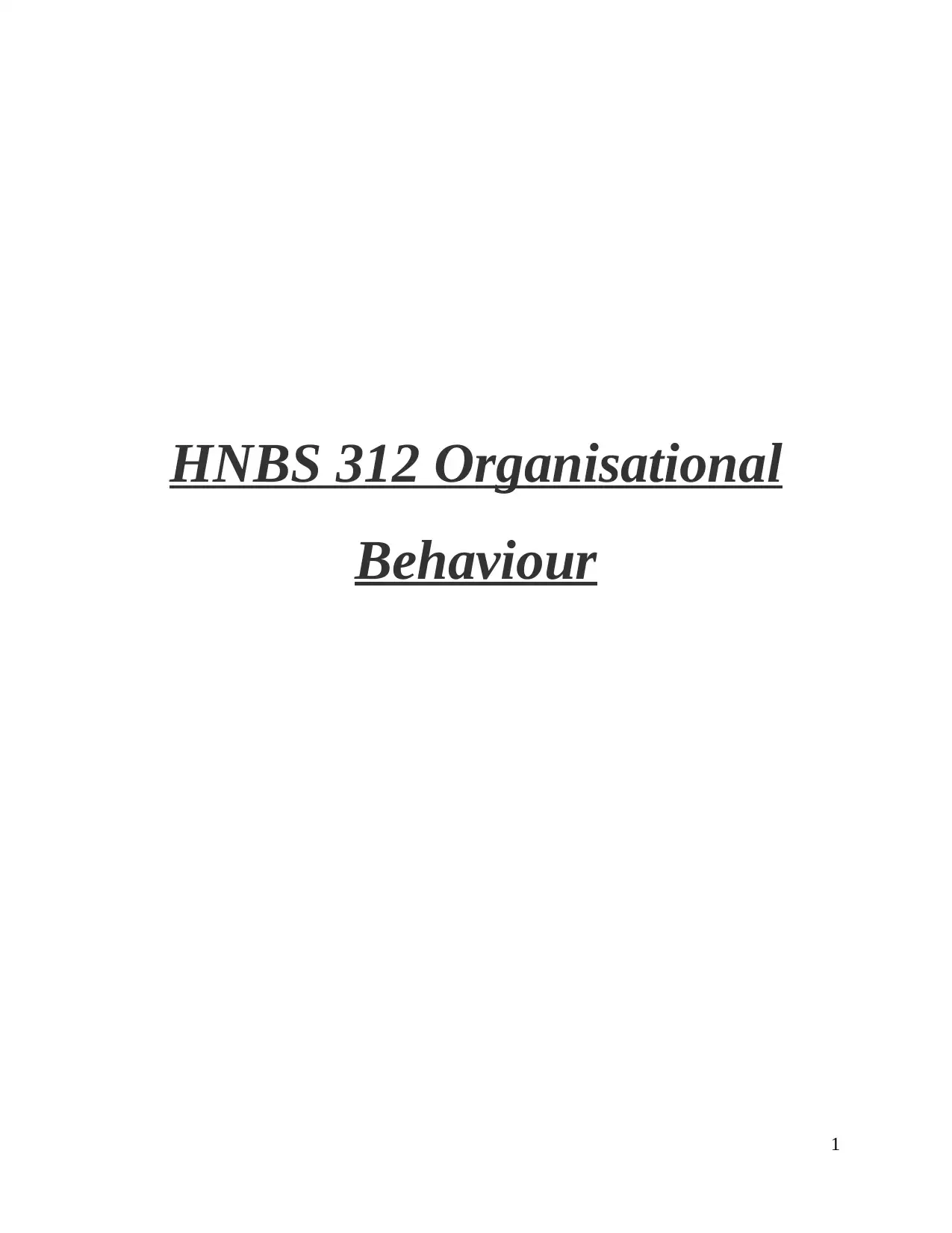
HNBS 312 Organisational
Behaviour
1
Behaviour
1
Paraphrase This Document
Need a fresh take? Get an instant paraphrase of this document with our AI Paraphraser
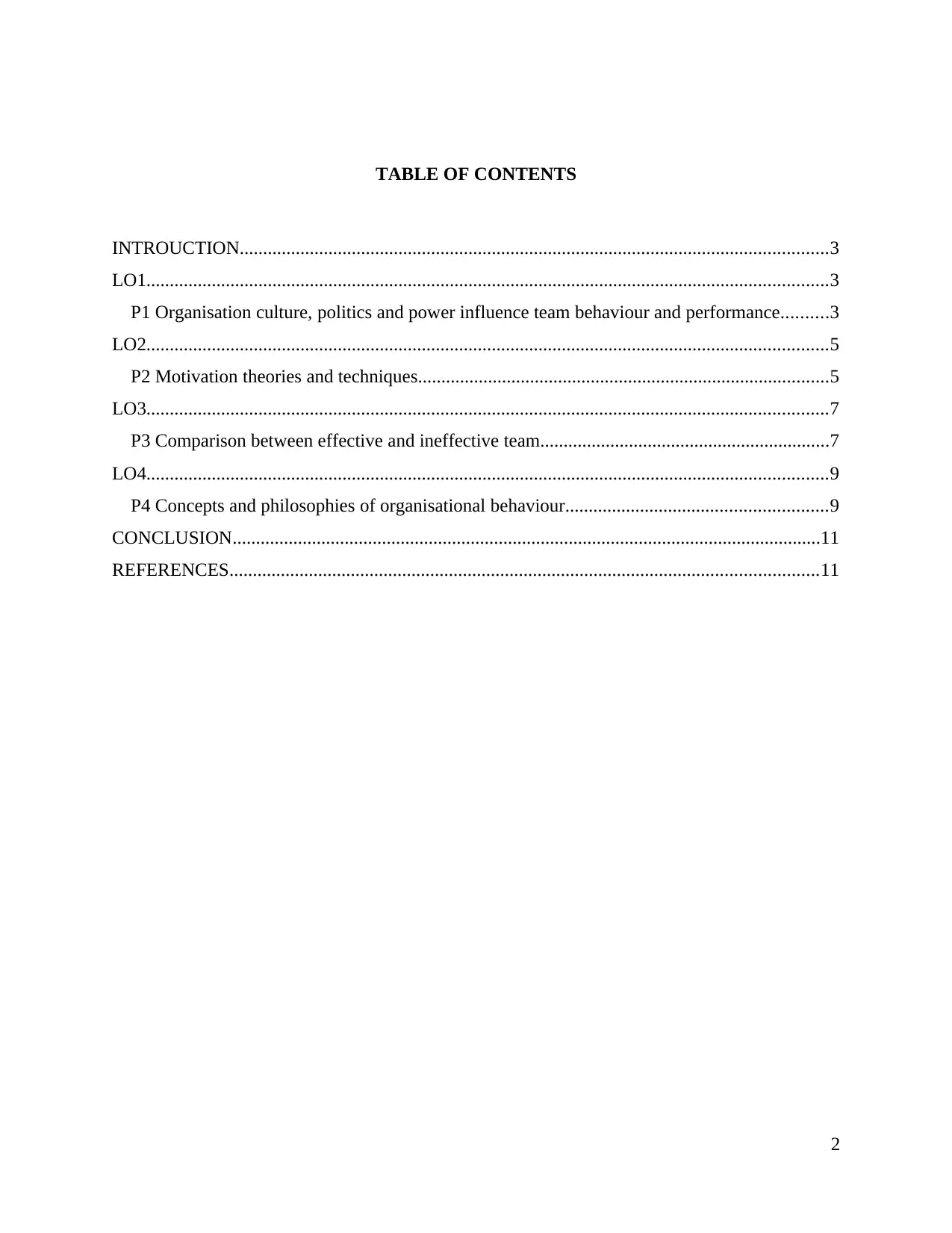
TABLE OF CONTENTS
INTROUCTION..............................................................................................................................3
LO1..................................................................................................................................................3
P1 Organisation culture, politics and power influence team behaviour and performance..........3
LO2..................................................................................................................................................5
P2 Motivation theories and techniques........................................................................................5
LO3..................................................................................................................................................7
P3 Comparison between effective and ineffective team..............................................................7
LO4..................................................................................................................................................9
P4 Concepts and philosophies of organisational behaviour........................................................9
CONCLUSION..............................................................................................................................11
REFERENCES..............................................................................................................................11
2
INTROUCTION..............................................................................................................................3
LO1..................................................................................................................................................3
P1 Organisation culture, politics and power influence team behaviour and performance..........3
LO2..................................................................................................................................................5
P2 Motivation theories and techniques........................................................................................5
LO3..................................................................................................................................................7
P3 Comparison between effective and ineffective team..............................................................7
LO4..................................................................................................................................................9
P4 Concepts and philosophies of organisational behaviour........................................................9
CONCLUSION..............................................................................................................................11
REFERENCES..............................................................................................................................11
2
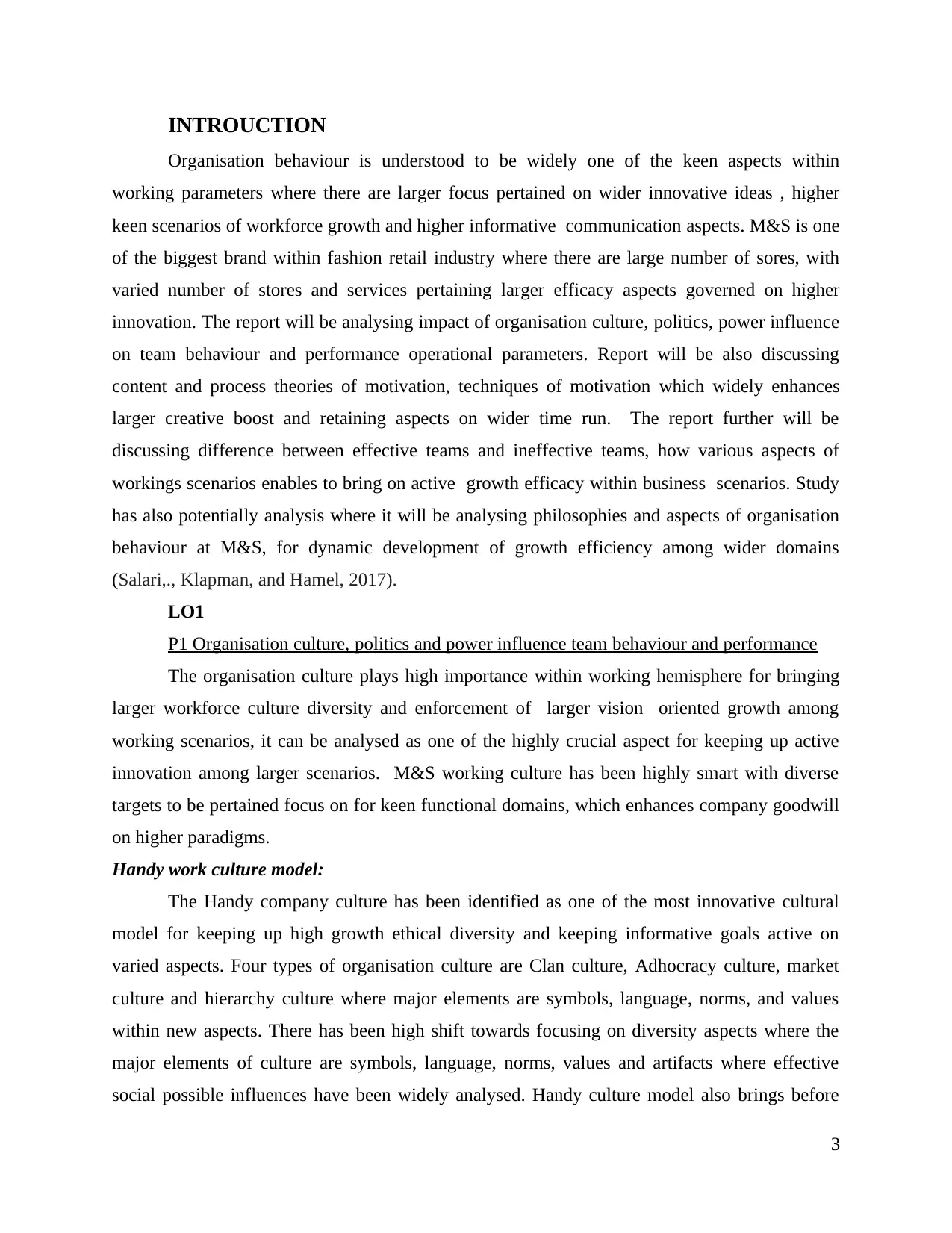
INTROUCTION
Organisation behaviour is understood to be widely one of the keen aspects within
working parameters where there are larger focus pertained on wider innovative ideas , higher
keen scenarios of workforce growth and higher informative communication aspects. M&S is one
of the biggest brand within fashion retail industry where there are large number of sores, with
varied number of stores and services pertaining larger efficacy aspects governed on higher
innovation. The report will be analysing impact of organisation culture, politics, power influence
on team behaviour and performance operational parameters. Report will be also discussing
content and process theories of motivation, techniques of motivation which widely enhances
larger creative boost and retaining aspects on wider time run. The report further will be
discussing difference between effective teams and ineffective teams, how various aspects of
workings scenarios enables to bring on active growth efficacy within business scenarios. Study
has also potentially analysis where it will be analysing philosophies and aspects of organisation
behaviour at M&S, for dynamic development of growth efficiency among wider domains
(Salari,., Klapman, and Hamel, 2017).
LO1
P1 Organisation culture, politics and power influence team behaviour and performance
The organisation culture plays high importance within working hemisphere for bringing
larger workforce culture diversity and enforcement of larger vision oriented growth among
working scenarios, it can be analysed as one of the highly crucial aspect for keeping up active
innovation among larger scenarios. M&S working culture has been highly smart with diverse
targets to be pertained focus on for keen functional domains, which enhances company goodwill
on higher paradigms.
Handy work culture model:
The Handy company culture has been identified as one of the most innovative cultural
model for keeping up high growth ethical diversity and keeping informative goals active on
varied aspects. Four types of organisation culture are Clan culture, Adhocracy culture, market
culture and hierarchy culture where major elements are symbols, language, norms, and values
within new aspects. There has been high shift towards focusing on diversity aspects where the
major elements of culture are symbols, language, norms, values and artifacts where effective
social possible influences have been widely analysed. Handy culture model also brings before
3
Organisation behaviour is understood to be widely one of the keen aspects within
working parameters where there are larger focus pertained on wider innovative ideas , higher
keen scenarios of workforce growth and higher informative communication aspects. M&S is one
of the biggest brand within fashion retail industry where there are large number of sores, with
varied number of stores and services pertaining larger efficacy aspects governed on higher
innovation. The report will be analysing impact of organisation culture, politics, power influence
on team behaviour and performance operational parameters. Report will be also discussing
content and process theories of motivation, techniques of motivation which widely enhances
larger creative boost and retaining aspects on wider time run. The report further will be
discussing difference between effective teams and ineffective teams, how various aspects of
workings scenarios enables to bring on active growth efficacy within business scenarios. Study
has also potentially analysis where it will be analysing philosophies and aspects of organisation
behaviour at M&S, for dynamic development of growth efficiency among wider domains
(Salari,., Klapman, and Hamel, 2017).
LO1
P1 Organisation culture, politics and power influence team behaviour and performance
The organisation culture plays high importance within working hemisphere for bringing
larger workforce culture diversity and enforcement of larger vision oriented growth among
working scenarios, it can be analysed as one of the highly crucial aspect for keeping up active
innovation among larger scenarios. M&S working culture has been highly smart with diverse
targets to be pertained focus on for keen functional domains, which enhances company goodwill
on higher paradigms.
Handy work culture model:
The Handy company culture has been identified as one of the most innovative cultural
model for keeping up high growth ethical diversity and keeping informative goals active on
varied aspects. Four types of organisation culture are Clan culture, Adhocracy culture, market
culture and hierarchy culture where major elements are symbols, language, norms, and values
within new aspects. There has been high shift towards focusing on diversity aspects where the
major elements of culture are symbols, language, norms, values and artifacts where effective
social possible influences have been widely analysed. Handy culture model also brings before
3
⊘ This is a preview!⊘
Do you want full access?
Subscribe today to unlock all pages.

Trusted by 1+ million students worldwide
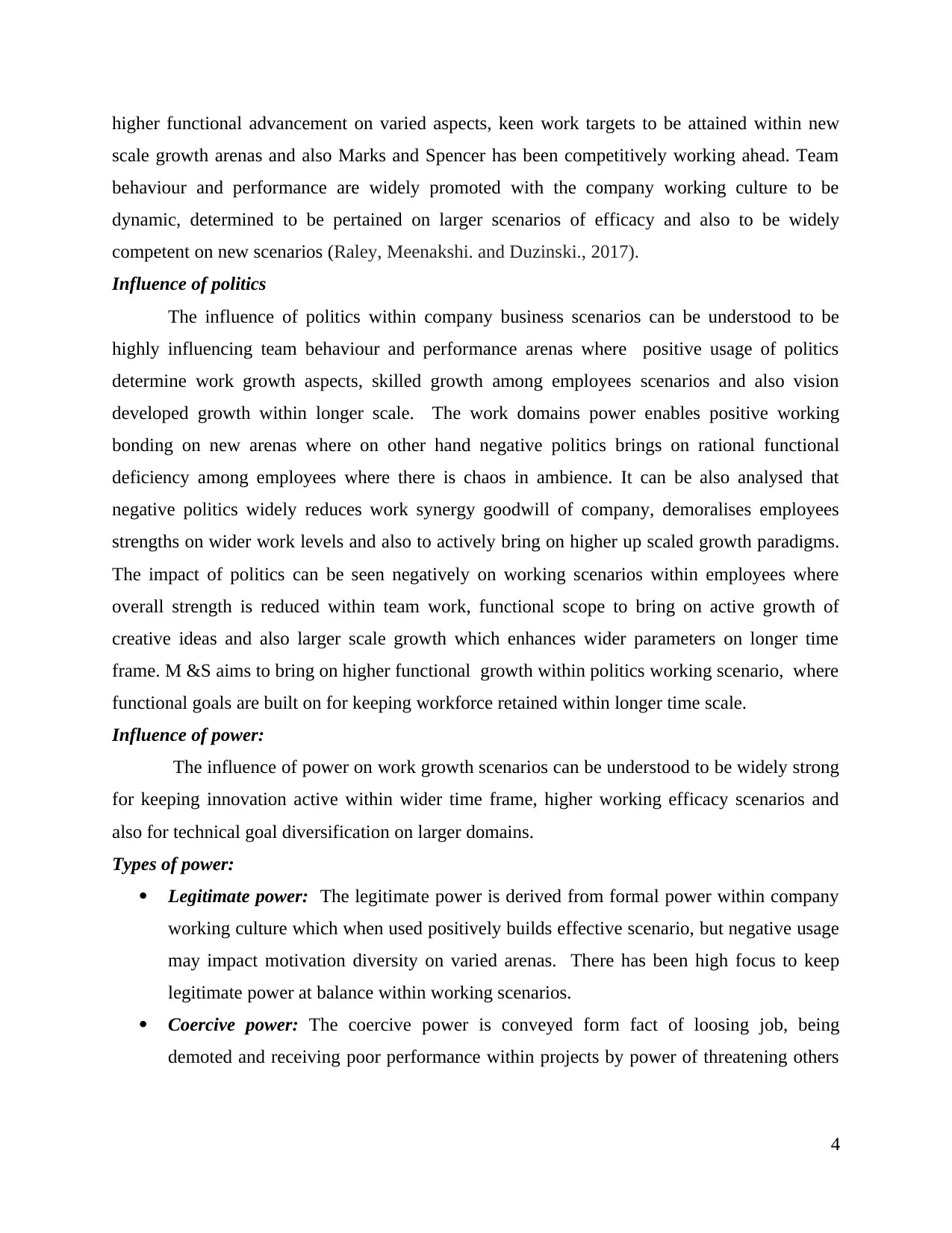
higher functional advancement on varied aspects, keen work targets to be attained within new
scale growth arenas and also Marks and Spencer has been competitively working ahead. Team
behaviour and performance are widely promoted with the company working culture to be
dynamic, determined to be pertained on larger scenarios of efficacy and also to be widely
competent on new scenarios (Raley, Meenakshi. and Duzinski., 2017).
Influence of politics
The influence of politics within company business scenarios can be understood to be
highly influencing team behaviour and performance arenas where positive usage of politics
determine work growth aspects, skilled growth among employees scenarios and also vision
developed growth within longer scale. The work domains power enables positive working
bonding on new arenas where on other hand negative politics brings on rational functional
deficiency among employees where there is chaos in ambience. It can be also analysed that
negative politics widely reduces work synergy goodwill of company, demoralises employees
strengths on wider work levels and also to actively bring on higher up scaled growth paradigms.
The impact of politics can be seen negatively on working scenarios within employees where
overall strength is reduced within team work, functional scope to bring on active growth of
creative ideas and also larger scale growth which enhances wider parameters on longer time
frame. M &S aims to bring on higher functional growth within politics working scenario, where
functional goals are built on for keeping workforce retained within longer time scale.
Influence of power:
The influence of power on work growth scenarios can be understood to be widely strong
for keeping innovation active within wider time frame, higher working efficacy scenarios and
also for technical goal diversification on larger domains.
Types of power:
Legitimate power: The legitimate power is derived from formal power within company
working culture which when used positively builds effective scenario, but negative usage
may impact motivation diversity on varied arenas. There has been high focus to keep
legitimate power at balance within working scenarios.
Coercive power: The coercive power is conveyed form fact of loosing job, being
demoted and receiving poor performance within projects by power of threatening others
4
scale growth arenas and also Marks and Spencer has been competitively working ahead. Team
behaviour and performance are widely promoted with the company working culture to be
dynamic, determined to be pertained on larger scenarios of efficacy and also to be widely
competent on new scenarios (Raley, Meenakshi. and Duzinski., 2017).
Influence of politics
The influence of politics within company business scenarios can be understood to be
highly influencing team behaviour and performance arenas where positive usage of politics
determine work growth aspects, skilled growth among employees scenarios and also vision
developed growth within longer scale. The work domains power enables positive working
bonding on new arenas where on other hand negative politics brings on rational functional
deficiency among employees where there is chaos in ambience. It can be also analysed that
negative politics widely reduces work synergy goodwill of company, demoralises employees
strengths on wider work levels and also to actively bring on higher up scaled growth paradigms.
The impact of politics can be seen negatively on working scenarios within employees where
overall strength is reduced within team work, functional scope to bring on active growth of
creative ideas and also larger scale growth which enhances wider parameters on longer time
frame. M &S aims to bring on higher functional growth within politics working scenario, where
functional goals are built on for keeping workforce retained within longer time scale.
Influence of power:
The influence of power on work growth scenarios can be understood to be widely strong
for keeping innovation active within wider time frame, higher working efficacy scenarios and
also for technical goal diversification on larger domains.
Types of power:
Legitimate power: The legitimate power is derived from formal power within company
working culture which when used positively builds effective scenario, but negative usage
may impact motivation diversity on varied arenas. There has been high focus to keep
legitimate power at balance within working scenarios.
Coercive power: The coercive power is conveyed form fact of loosing job, being
demoted and receiving poor performance within projects by power of threatening others
4
Paraphrase This Document
Need a fresh take? Get an instant paraphrase of this document with our AI Paraphraser
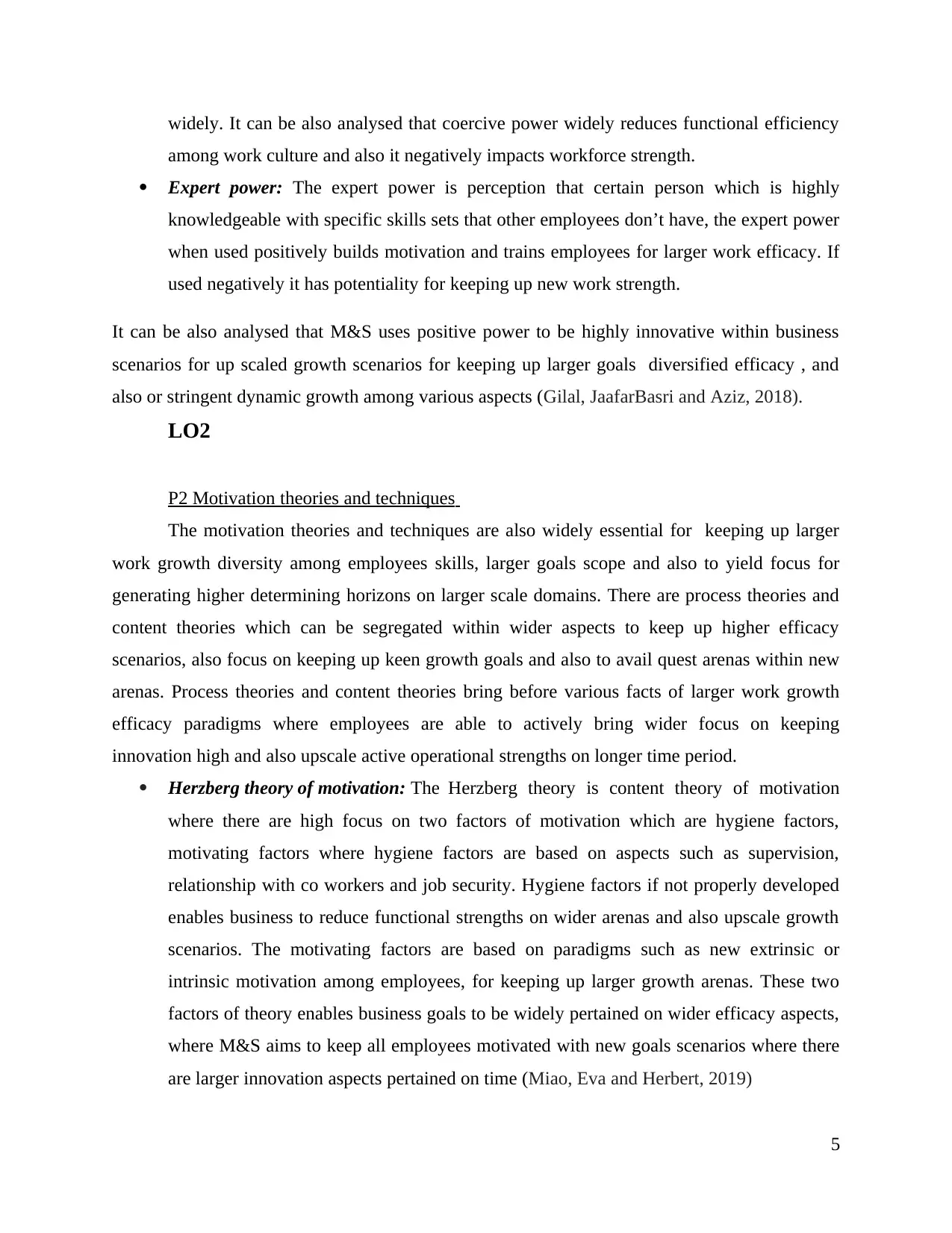
widely. It can be also analysed that coercive power widely reduces functional efficiency
among work culture and also it negatively impacts workforce strength.
Expert power: The expert power is perception that certain person which is highly
knowledgeable with specific skills sets that other employees don’t have, the expert power
when used positively builds motivation and trains employees for larger work efficacy. If
used negatively it has potentiality for keeping up new work strength.
It can be also analysed that M&S uses positive power to be highly innovative within business
scenarios for up scaled growth scenarios for keeping up larger goals diversified efficacy , and
also or stringent dynamic growth among various aspects (Gilal, JaafarBasri and Aziz, 2018).
LO2
P2 Motivation theories and techniques
The motivation theories and techniques are also widely essential for keeping up larger
work growth diversity among employees skills, larger goals scope and also to yield focus for
generating higher determining horizons on larger scale domains. There are process theories and
content theories which can be segregated within wider aspects to keep up higher efficacy
scenarios, also focus on keeping up keen growth goals and also to avail quest arenas within new
arenas. Process theories and content theories bring before various facts of larger work growth
efficacy paradigms where employees are able to actively bring wider focus on keeping
innovation high and also upscale active operational strengths on longer time period.
Herzberg theory of motivation: The Herzberg theory is content theory of motivation
where there are high focus on two factors of motivation which are hygiene factors,
motivating factors where hygiene factors are based on aspects such as supervision,
relationship with co workers and job security. Hygiene factors if not properly developed
enables business to reduce functional strengths on wider arenas and also upscale growth
scenarios. The motivating factors are based on paradigms such as new extrinsic or
intrinsic motivation among employees, for keeping up larger growth arenas. These two
factors of theory enables business goals to be widely pertained on wider efficacy aspects,
where M&S aims to keep all employees motivated with new goals scenarios where there
are larger innovation aspects pertained on time (Miao, Eva and Herbert, 2019)
5
among work culture and also it negatively impacts workforce strength.
Expert power: The expert power is perception that certain person which is highly
knowledgeable with specific skills sets that other employees don’t have, the expert power
when used positively builds motivation and trains employees for larger work efficacy. If
used negatively it has potentiality for keeping up new work strength.
It can be also analysed that M&S uses positive power to be highly innovative within business
scenarios for up scaled growth scenarios for keeping up larger goals diversified efficacy , and
also or stringent dynamic growth among various aspects (Gilal, JaafarBasri and Aziz, 2018).
LO2
P2 Motivation theories and techniques
The motivation theories and techniques are also widely essential for keeping up larger
work growth diversity among employees skills, larger goals scope and also to yield focus for
generating higher determining horizons on larger scale domains. There are process theories and
content theories which can be segregated within wider aspects to keep up higher efficacy
scenarios, also focus on keeping up keen growth goals and also to avail quest arenas within new
arenas. Process theories and content theories bring before various facts of larger work growth
efficacy paradigms where employees are able to actively bring wider focus on keeping
innovation high and also upscale active operational strengths on longer time period.
Herzberg theory of motivation: The Herzberg theory is content theory of motivation
where there are high focus on two factors of motivation which are hygiene factors,
motivating factors where hygiene factors are based on aspects such as supervision,
relationship with co workers and job security. Hygiene factors if not properly developed
enables business to reduce functional strengths on wider arenas and also upscale growth
scenarios. The motivating factors are based on paradigms such as new extrinsic or
intrinsic motivation among employees, for keeping up larger growth arenas. These two
factors of theory enables business goals to be widely pertained on wider efficacy aspects,
where M&S aims to keep all employees motivated with new goals scenarios where there
are larger innovation aspects pertained on time (Miao, Eva and Herbert, 2019)
5
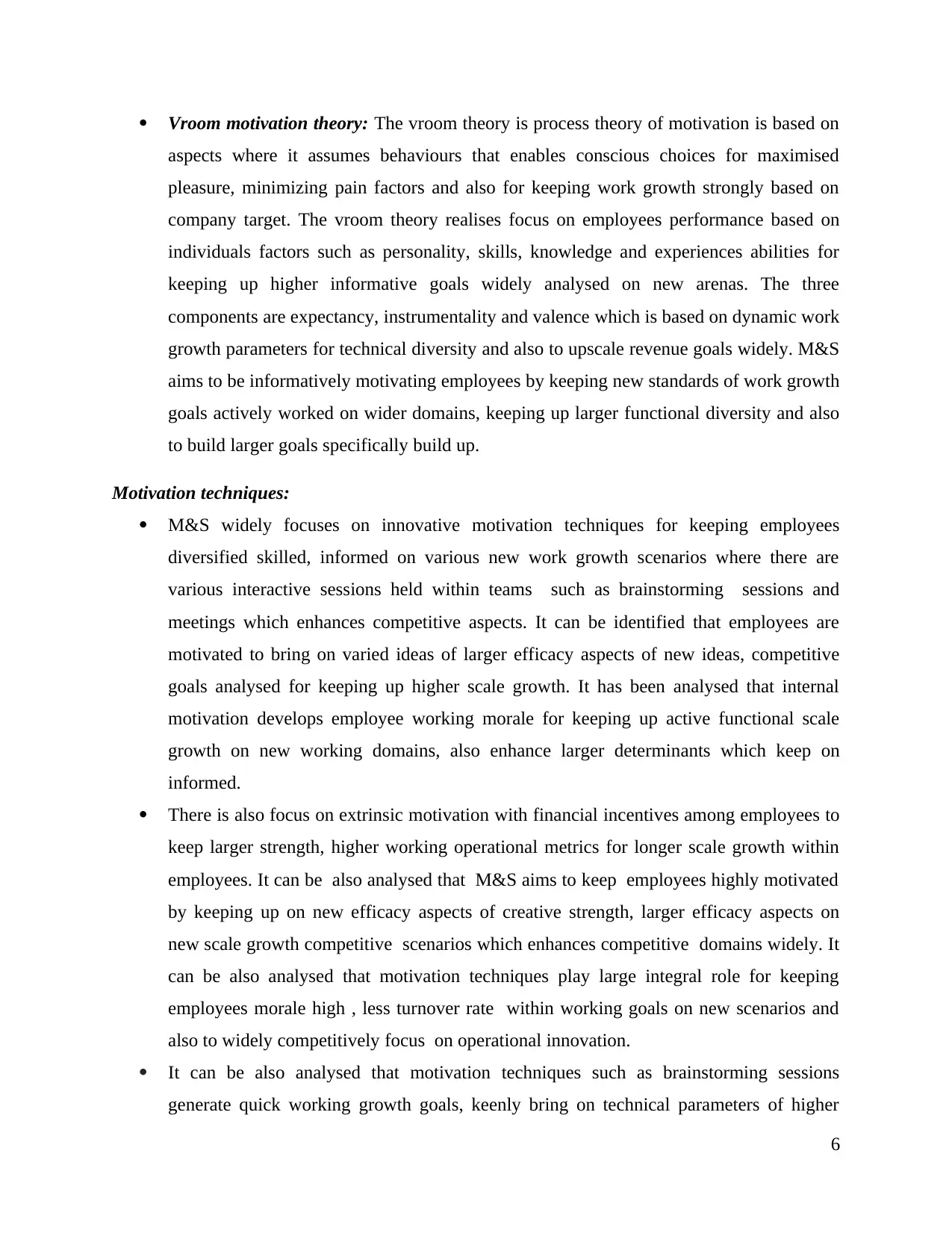
Vroom motivation theory: The vroom theory is process theory of motivation is based on
aspects where it assumes behaviours that enables conscious choices for maximised
pleasure, minimizing pain factors and also for keeping work growth strongly based on
company target. The vroom theory realises focus on employees performance based on
individuals factors such as personality, skills, knowledge and experiences abilities for
keeping up higher informative goals widely analysed on new arenas. The three
components are expectancy, instrumentality and valence which is based on dynamic work
growth parameters for technical diversity and also to upscale revenue goals widely. M&S
aims to be informatively motivating employees by keeping new standards of work growth
goals actively worked on wider domains, keeping up larger functional diversity and also
to build larger goals specifically build up.
Motivation techniques:
M&S widely focuses on innovative motivation techniques for keeping employees
diversified skilled, informed on various new work growth scenarios where there are
various interactive sessions held within teams such as brainstorming sessions and
meetings which enhances competitive aspects. It can be identified that employees are
motivated to bring on varied ideas of larger efficacy aspects of new ideas, competitive
goals analysed for keeping up higher scale growth. It has been analysed that internal
motivation develops employee working morale for keeping up active functional scale
growth on new working domains, also enhance larger determinants which keep on
informed.
There is also focus on extrinsic motivation with financial incentives among employees to
keep larger strength, higher working operational metrics for longer scale growth within
employees. It can be also analysed that M&S aims to keep employees highly motivated
by keeping up on new efficacy aspects of creative strength, larger efficacy aspects on
new scale growth competitive scenarios which enhances competitive domains widely. It
can be also analysed that motivation techniques play large integral role for keeping
employees morale high , less turnover rate within working goals on new scenarios and
also to widely competitively focus on operational innovation.
It can be also analysed that motivation techniques such as brainstorming sessions
generate quick working growth goals, keenly bring on technical parameters of higher
6
aspects where it assumes behaviours that enables conscious choices for maximised
pleasure, minimizing pain factors and also for keeping work growth strongly based on
company target. The vroom theory realises focus on employees performance based on
individuals factors such as personality, skills, knowledge and experiences abilities for
keeping up higher informative goals widely analysed on new arenas. The three
components are expectancy, instrumentality and valence which is based on dynamic work
growth parameters for technical diversity and also to upscale revenue goals widely. M&S
aims to be informatively motivating employees by keeping new standards of work growth
goals actively worked on wider domains, keeping up larger functional diversity and also
to build larger goals specifically build up.
Motivation techniques:
M&S widely focuses on innovative motivation techniques for keeping employees
diversified skilled, informed on various new work growth scenarios where there are
various interactive sessions held within teams such as brainstorming sessions and
meetings which enhances competitive aspects. It can be identified that employees are
motivated to bring on varied ideas of larger efficacy aspects of new ideas, competitive
goals analysed for keeping up higher scale growth. It has been analysed that internal
motivation develops employee working morale for keeping up active functional scale
growth on new working domains, also enhance larger determinants which keep on
informed.
There is also focus on extrinsic motivation with financial incentives among employees to
keep larger strength, higher working operational metrics for longer scale growth within
employees. It can be also analysed that M&S aims to keep employees highly motivated
by keeping up on new efficacy aspects of creative strength, larger efficacy aspects on
new scale growth competitive scenarios which enhances competitive domains widely. It
can be also analysed that motivation techniques play large integral role for keeping
employees morale high , less turnover rate within working goals on new scenarios and
also to widely competitively focus on operational innovation.
It can be also analysed that motivation techniques such as brainstorming sessions
generate quick working growth goals, keenly bring on technical parameters of higher
6
⊘ This is a preview!⊘
Do you want full access?
Subscribe today to unlock all pages.

Trusted by 1+ million students worldwide
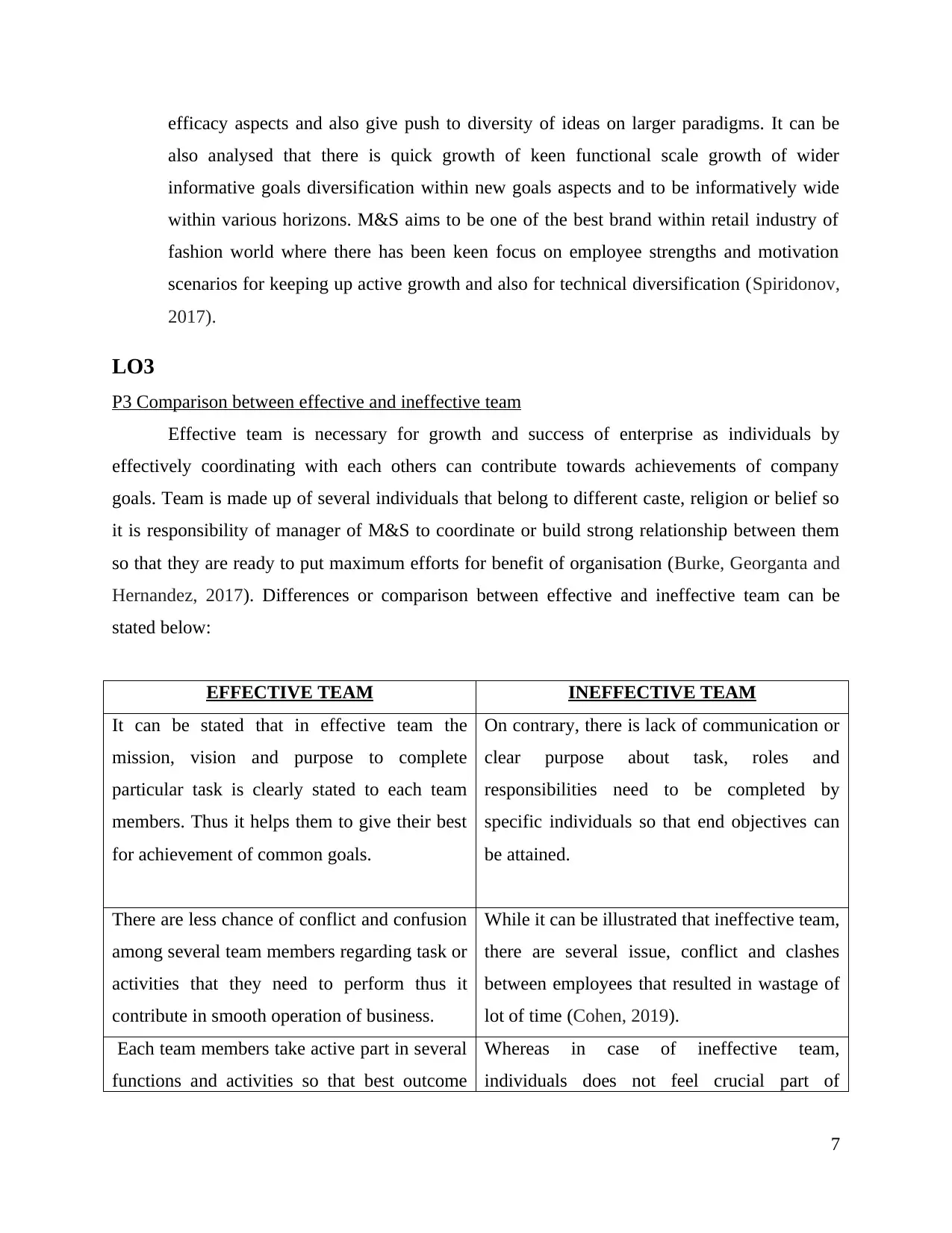
efficacy aspects and also give push to diversity of ideas on larger paradigms. It can be
also analysed that there is quick growth of keen functional scale growth of wider
informative goals diversification within new goals aspects and to be informatively wide
within various horizons. M&S aims to be one of the best brand within retail industry of
fashion world where there has been keen focus on employee strengths and motivation
scenarios for keeping up active growth and also for technical diversification (Spiridonov,
2017).
LO3
P3 Comparison between effective and ineffective team
Effective team is necessary for growth and success of enterprise as individuals by
effectively coordinating with each others can contribute towards achievements of company
goals. Team is made up of several individuals that belong to different caste, religion or belief so
it is responsibility of manager of M&S to coordinate or build strong relationship between them
so that they are ready to put maximum efforts for benefit of organisation (Burke, Georganta and
Hernandez, 2017). Differences or comparison between effective and ineffective team can be
stated below:
EFFECTIVE TEAM INEFFECTIVE TEAM
It can be stated that in effective team the
mission, vision and purpose to complete
particular task is clearly stated to each team
members. Thus it helps them to give their best
for achievement of common goals.
On contrary, there is lack of communication or
clear purpose about task, roles and
responsibilities need to be completed by
specific individuals so that end objectives can
be attained.
There are less chance of conflict and confusion
among several team members regarding task or
activities that they need to perform thus it
contribute in smooth operation of business.
While it can be illustrated that ineffective team,
there are several issue, conflict and clashes
between employees that resulted in wastage of
lot of time (Cohen, 2019).
Each team members take active part in several
functions and activities so that best outcome
Whereas in case of ineffective team,
individuals does not feel crucial part of
7
also analysed that there is quick growth of keen functional scale growth of wider
informative goals diversification within new goals aspects and to be informatively wide
within various horizons. M&S aims to be one of the best brand within retail industry of
fashion world where there has been keen focus on employee strengths and motivation
scenarios for keeping up active growth and also for technical diversification (Spiridonov,
2017).
LO3
P3 Comparison between effective and ineffective team
Effective team is necessary for growth and success of enterprise as individuals by
effectively coordinating with each others can contribute towards achievements of company
goals. Team is made up of several individuals that belong to different caste, religion or belief so
it is responsibility of manager of M&S to coordinate or build strong relationship between them
so that they are ready to put maximum efforts for benefit of organisation (Burke, Georganta and
Hernandez, 2017). Differences or comparison between effective and ineffective team can be
stated below:
EFFECTIVE TEAM INEFFECTIVE TEAM
It can be stated that in effective team the
mission, vision and purpose to complete
particular task is clearly stated to each team
members. Thus it helps them to give their best
for achievement of common goals.
On contrary, there is lack of communication or
clear purpose about task, roles and
responsibilities need to be completed by
specific individuals so that end objectives can
be attained.
There are less chance of conflict and confusion
among several team members regarding task or
activities that they need to perform thus it
contribute in smooth operation of business.
While it can be illustrated that ineffective team,
there are several issue, conflict and clashes
between employees that resulted in wastage of
lot of time (Cohen, 2019).
Each team members take active part in several
functions and activities so that best outcome
Whereas in case of ineffective team,
individuals does not feel crucial part of
7
Paraphrase This Document
Need a fresh take? Get an instant paraphrase of this document with our AI Paraphraser
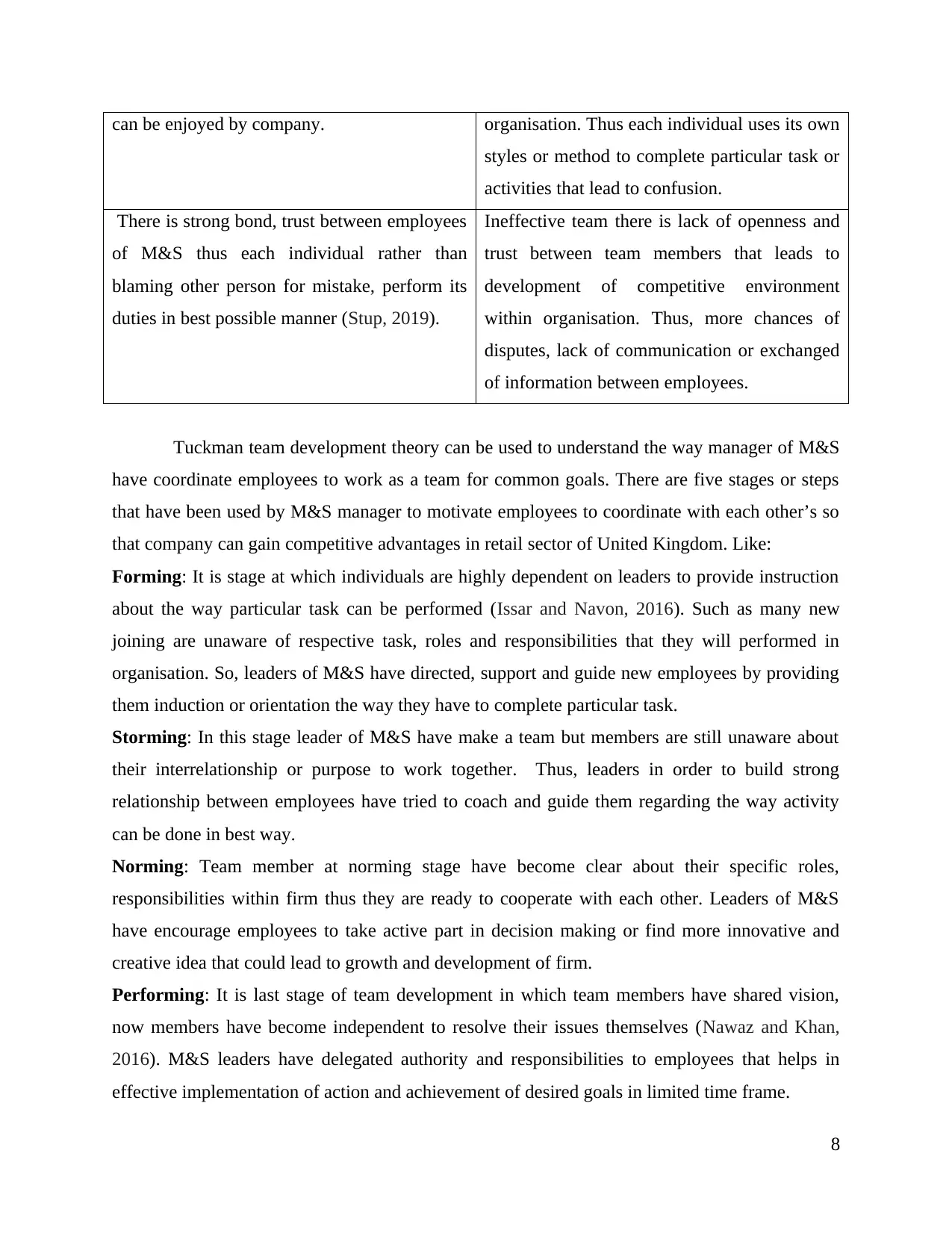
can be enjoyed by company. organisation. Thus each individual uses its own
styles or method to complete particular task or
activities that lead to confusion.
There is strong bond, trust between employees
of M&S thus each individual rather than
blaming other person for mistake, perform its
duties in best possible manner (Stup, 2019).
Ineffective team there is lack of openness and
trust between team members that leads to
development of competitive environment
within organisation. Thus, more chances of
disputes, lack of communication or exchanged
of information between employees.
Tuckman team development theory can be used to understand the way manager of M&S
have coordinate employees to work as a team for common goals. There are five stages or steps
that have been used by M&S manager to motivate employees to coordinate with each other’s so
that company can gain competitive advantages in retail sector of United Kingdom. Like:
Forming: It is stage at which individuals are highly dependent on leaders to provide instruction
about the way particular task can be performed (Issar and Navon, 2016). Such as many new
joining are unaware of respective task, roles and responsibilities that they will performed in
organisation. So, leaders of M&S have directed, support and guide new employees by providing
them induction or orientation the way they have to complete particular task.
Storming: In this stage leader of M&S have make a team but members are still unaware about
their interrelationship or purpose to work together. Thus, leaders in order to build strong
relationship between employees have tried to coach and guide them regarding the way activity
can be done in best way.
Norming: Team member at norming stage have become clear about their specific roles,
responsibilities within firm thus they are ready to cooperate with each other. Leaders of M&S
have encourage employees to take active part in decision making or find more innovative and
creative idea that could lead to growth and development of firm.
Performing: It is last stage of team development in which team members have shared vision,
now members have become independent to resolve their issues themselves (Nawaz and Khan,
2016). M&S leaders have delegated authority and responsibilities to employees that helps in
effective implementation of action and achievement of desired goals in limited time frame.
8
styles or method to complete particular task or
activities that lead to confusion.
There is strong bond, trust between employees
of M&S thus each individual rather than
blaming other person for mistake, perform its
duties in best possible manner (Stup, 2019).
Ineffective team there is lack of openness and
trust between team members that leads to
development of competitive environment
within organisation. Thus, more chances of
disputes, lack of communication or exchanged
of information between employees.
Tuckman team development theory can be used to understand the way manager of M&S
have coordinate employees to work as a team for common goals. There are five stages or steps
that have been used by M&S manager to motivate employees to coordinate with each other’s so
that company can gain competitive advantages in retail sector of United Kingdom. Like:
Forming: It is stage at which individuals are highly dependent on leaders to provide instruction
about the way particular task can be performed (Issar and Navon, 2016). Such as many new
joining are unaware of respective task, roles and responsibilities that they will performed in
organisation. So, leaders of M&S have directed, support and guide new employees by providing
them induction or orientation the way they have to complete particular task.
Storming: In this stage leader of M&S have make a team but members are still unaware about
their interrelationship or purpose to work together. Thus, leaders in order to build strong
relationship between employees have tried to coach and guide them regarding the way activity
can be done in best way.
Norming: Team member at norming stage have become clear about their specific roles,
responsibilities within firm thus they are ready to cooperate with each other. Leaders of M&S
have encourage employees to take active part in decision making or find more innovative and
creative idea that could lead to growth and development of firm.
Performing: It is last stage of team development in which team members have shared vision,
now members have become independent to resolve their issues themselves (Nawaz and Khan,
2016). M&S leaders have delegated authority and responsibilities to employees that helps in
effective implementation of action and achievement of desired goals in limited time frame.
8
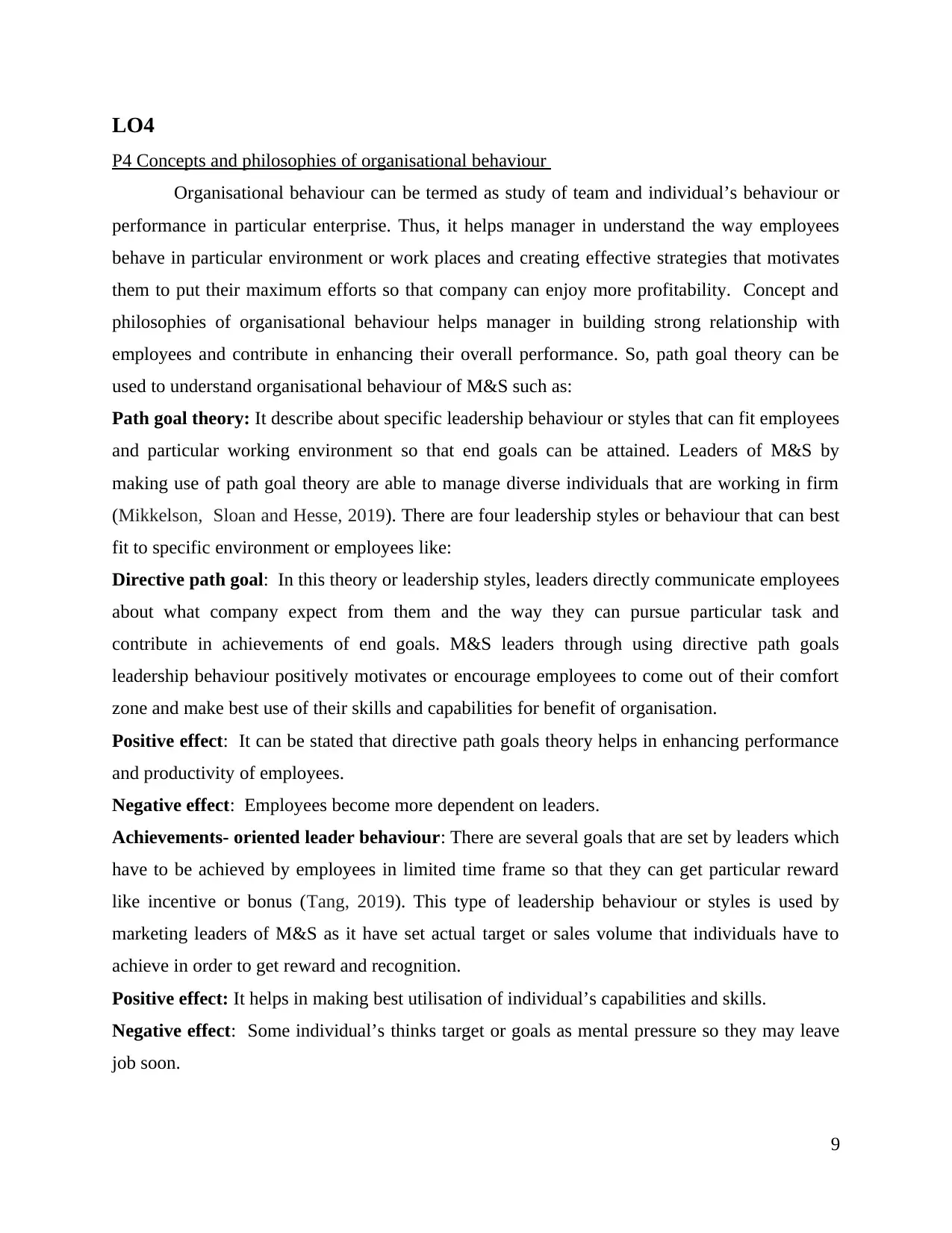
LO4
P4 Concepts and philosophies of organisational behaviour
Organisational behaviour can be termed as study of team and individual’s behaviour or
performance in particular enterprise. Thus, it helps manager in understand the way employees
behave in particular environment or work places and creating effective strategies that motivates
them to put their maximum efforts so that company can enjoy more profitability. Concept and
philosophies of organisational behaviour helps manager in building strong relationship with
employees and contribute in enhancing their overall performance. So, path goal theory can be
used to understand organisational behaviour of M&S such as:
Path goal theory: It describe about specific leadership behaviour or styles that can fit employees
and particular working environment so that end goals can be attained. Leaders of M&S by
making use of path goal theory are able to manage diverse individuals that are working in firm
(Mikkelson, Sloan and Hesse, 2019). There are four leadership styles or behaviour that can best
fit to specific environment or employees like:
Directive path goal: In this theory or leadership styles, leaders directly communicate employees
about what company expect from them and the way they can pursue particular task and
contribute in achievements of end goals. M&S leaders through using directive path goals
leadership behaviour positively motivates or encourage employees to come out of their comfort
zone and make best use of their skills and capabilities for benefit of organisation.
Positive effect: It can be stated that directive path goals theory helps in enhancing performance
and productivity of employees.
Negative effect: Employees become more dependent on leaders.
Achievements- oriented leader behaviour: There are several goals that are set by leaders which
have to be achieved by employees in limited time frame so that they can get particular reward
like incentive or bonus (Tang, 2019). This type of leadership behaviour or styles is used by
marketing leaders of M&S as it have set actual target or sales volume that individuals have to
achieve in order to get reward and recognition.
Positive effect: It helps in making best utilisation of individual’s capabilities and skills.
Negative effect: Some individual’s thinks target or goals as mental pressure so they may leave
job soon.
9
P4 Concepts and philosophies of organisational behaviour
Organisational behaviour can be termed as study of team and individual’s behaviour or
performance in particular enterprise. Thus, it helps manager in understand the way employees
behave in particular environment or work places and creating effective strategies that motivates
them to put their maximum efforts so that company can enjoy more profitability. Concept and
philosophies of organisational behaviour helps manager in building strong relationship with
employees and contribute in enhancing their overall performance. So, path goal theory can be
used to understand organisational behaviour of M&S such as:
Path goal theory: It describe about specific leadership behaviour or styles that can fit employees
and particular working environment so that end goals can be attained. Leaders of M&S by
making use of path goal theory are able to manage diverse individuals that are working in firm
(Mikkelson, Sloan and Hesse, 2019). There are four leadership styles or behaviour that can best
fit to specific environment or employees like:
Directive path goal: In this theory or leadership styles, leaders directly communicate employees
about what company expect from them and the way they can pursue particular task and
contribute in achievements of end goals. M&S leaders through using directive path goals
leadership behaviour positively motivates or encourage employees to come out of their comfort
zone and make best use of their skills and capabilities for benefit of organisation.
Positive effect: It can be stated that directive path goals theory helps in enhancing performance
and productivity of employees.
Negative effect: Employees become more dependent on leaders.
Achievements- oriented leader behaviour: There are several goals that are set by leaders which
have to be achieved by employees in limited time frame so that they can get particular reward
like incentive or bonus (Tang, 2019). This type of leadership behaviour or styles is used by
marketing leaders of M&S as it have set actual target or sales volume that individuals have to
achieve in order to get reward and recognition.
Positive effect: It helps in making best utilisation of individual’s capabilities and skills.
Negative effect: Some individual’s thinks target or goals as mental pressure so they may leave
job soon.
9
⊘ This is a preview!⊘
Do you want full access?
Subscribe today to unlock all pages.

Trusted by 1+ million students worldwide
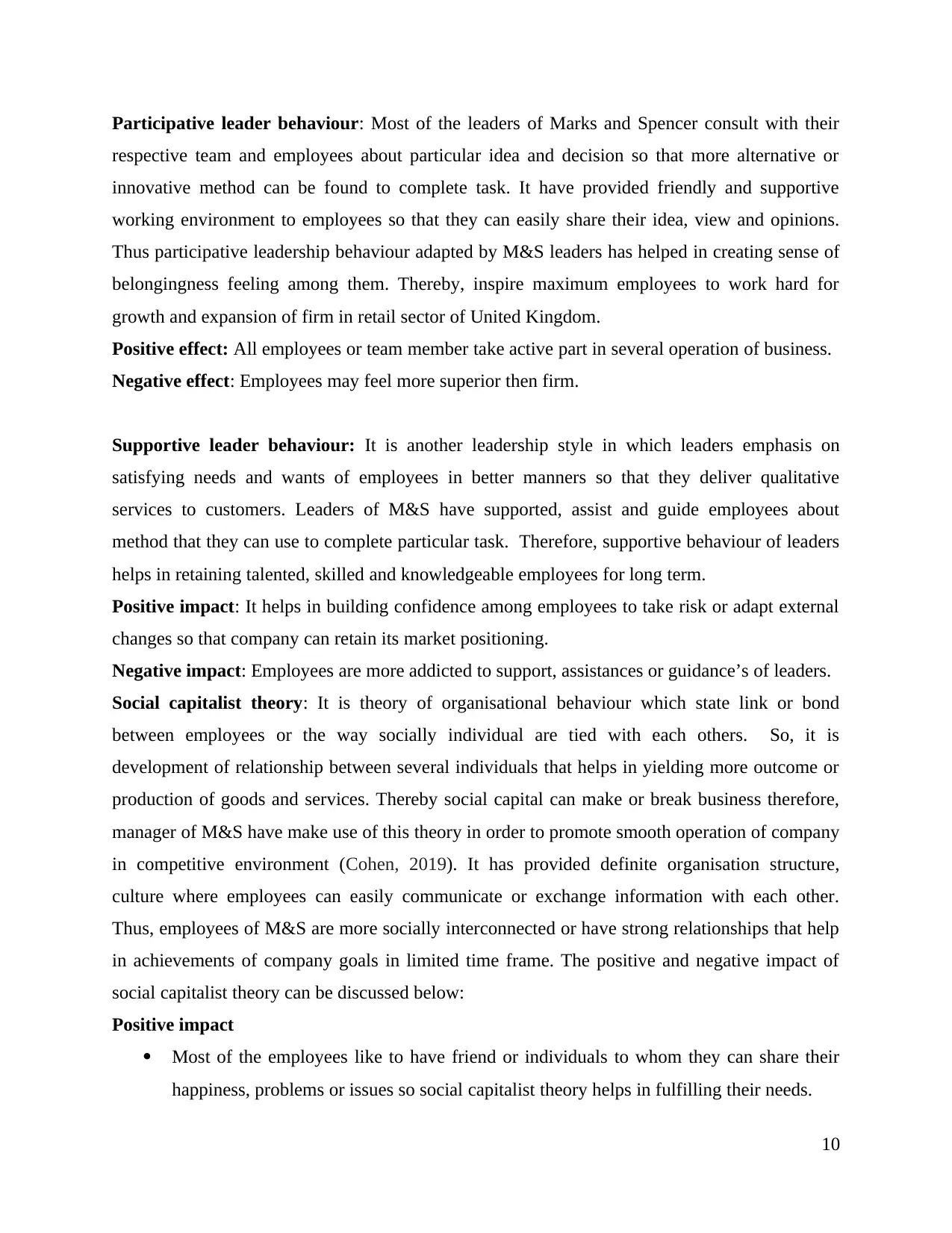
Participative leader behaviour: Most of the leaders of Marks and Spencer consult with their
respective team and employees about particular idea and decision so that more alternative or
innovative method can be found to complete task. It have provided friendly and supportive
working environment to employees so that they can easily share their idea, view and opinions.
Thus participative leadership behaviour adapted by M&S leaders has helped in creating sense of
belongingness feeling among them. Thereby, inspire maximum employees to work hard for
growth and expansion of firm in retail sector of United Kingdom.
Positive effect: All employees or team member take active part in several operation of business.
Negative effect: Employees may feel more superior then firm.
Supportive leader behaviour: It is another leadership style in which leaders emphasis on
satisfying needs and wants of employees in better manners so that they deliver qualitative
services to customers. Leaders of M&S have supported, assist and guide employees about
method that they can use to complete particular task. Therefore, supportive behaviour of leaders
helps in retaining talented, skilled and knowledgeable employees for long term.
Positive impact: It helps in building confidence among employees to take risk or adapt external
changes so that company can retain its market positioning.
Negative impact: Employees are more addicted to support, assistances or guidance’s of leaders.
Social capitalist theory: It is theory of organisational behaviour which state link or bond
between employees or the way socially individual are tied with each others. So, it is
development of relationship between several individuals that helps in yielding more outcome or
production of goods and services. Thereby social capital can make or break business therefore,
manager of M&S have make use of this theory in order to promote smooth operation of company
in competitive environment (Cohen, 2019). It has provided definite organisation structure,
culture where employees can easily communicate or exchange information with each other.
Thus, employees of M&S are more socially interconnected or have strong relationships that help
in achievements of company goals in limited time frame. The positive and negative impact of
social capitalist theory can be discussed below:
Positive impact
Most of the employees like to have friend or individuals to whom they can share their
happiness, problems or issues so social capitalist theory helps in fulfilling their needs.
10
respective team and employees about particular idea and decision so that more alternative or
innovative method can be found to complete task. It have provided friendly and supportive
working environment to employees so that they can easily share their idea, view and opinions.
Thus participative leadership behaviour adapted by M&S leaders has helped in creating sense of
belongingness feeling among them. Thereby, inspire maximum employees to work hard for
growth and expansion of firm in retail sector of United Kingdom.
Positive effect: All employees or team member take active part in several operation of business.
Negative effect: Employees may feel more superior then firm.
Supportive leader behaviour: It is another leadership style in which leaders emphasis on
satisfying needs and wants of employees in better manners so that they deliver qualitative
services to customers. Leaders of M&S have supported, assist and guide employees about
method that they can use to complete particular task. Therefore, supportive behaviour of leaders
helps in retaining talented, skilled and knowledgeable employees for long term.
Positive impact: It helps in building confidence among employees to take risk or adapt external
changes so that company can retain its market positioning.
Negative impact: Employees are more addicted to support, assistances or guidance’s of leaders.
Social capitalist theory: It is theory of organisational behaviour which state link or bond
between employees or the way socially individual are tied with each others. So, it is
development of relationship between several individuals that helps in yielding more outcome or
production of goods and services. Thereby social capital can make or break business therefore,
manager of M&S have make use of this theory in order to promote smooth operation of company
in competitive environment (Cohen, 2019). It has provided definite organisation structure,
culture where employees can easily communicate or exchange information with each other.
Thus, employees of M&S are more socially interconnected or have strong relationships that help
in achievements of company goals in limited time frame. The positive and negative impact of
social capitalist theory can be discussed below:
Positive impact
Most of the employees like to have friend or individuals to whom they can share their
happiness, problems or issues so social capitalist theory helps in fulfilling their needs.
10
Paraphrase This Document
Need a fresh take? Get an instant paraphrase of this document with our AI Paraphraser
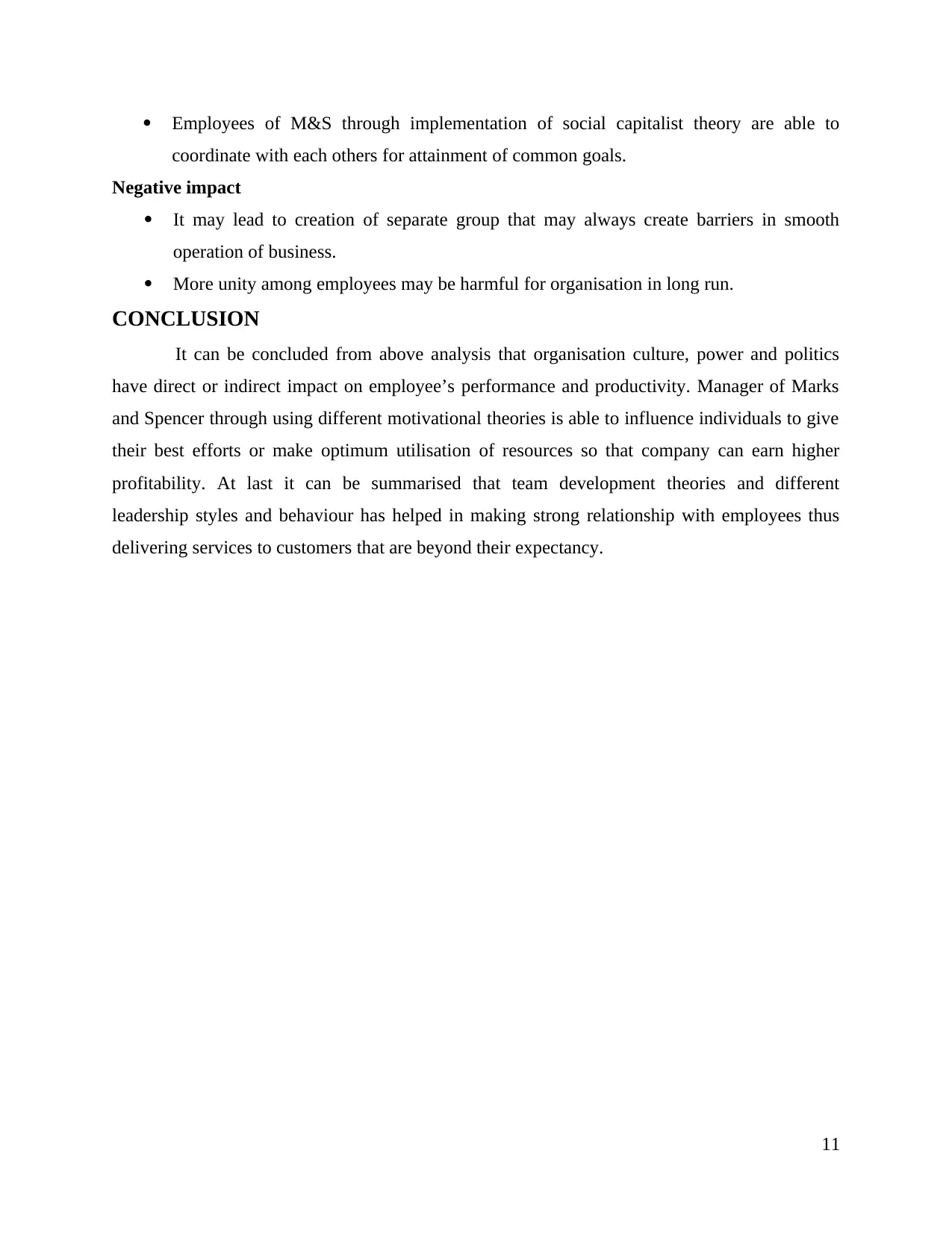
Employees of M&S through implementation of social capitalist theory are able to
coordinate with each others for attainment of common goals.
Negative impact
It may lead to creation of separate group that may always create barriers in smooth
operation of business.
More unity among employees may be harmful for organisation in long run.
CONCLUSION
It can be concluded from above analysis that organisation culture, power and politics
have direct or indirect impact on employee’s performance and productivity. Manager of Marks
and Spencer through using different motivational theories is able to influence individuals to give
their best efforts or make optimum utilisation of resources so that company can earn higher
profitability. At last it can be summarised that team development theories and different
leadership styles and behaviour has helped in making strong relationship with employees thus
delivering services to customers that are beyond their expectancy.
11
coordinate with each others for attainment of common goals.
Negative impact
It may lead to creation of separate group that may always create barriers in smooth
operation of business.
More unity among employees may be harmful for organisation in long run.
CONCLUSION
It can be concluded from above analysis that organisation culture, power and politics
have direct or indirect impact on employee’s performance and productivity. Manager of Marks
and Spencer through using different motivational theories is able to influence individuals to give
their best efforts or make optimum utilisation of resources so that company can earn higher
profitability. At last it can be summarised that team development theories and different
leadership styles and behaviour has helped in making strong relationship with employees thus
delivering services to customers that are beyond their expectancy.
11
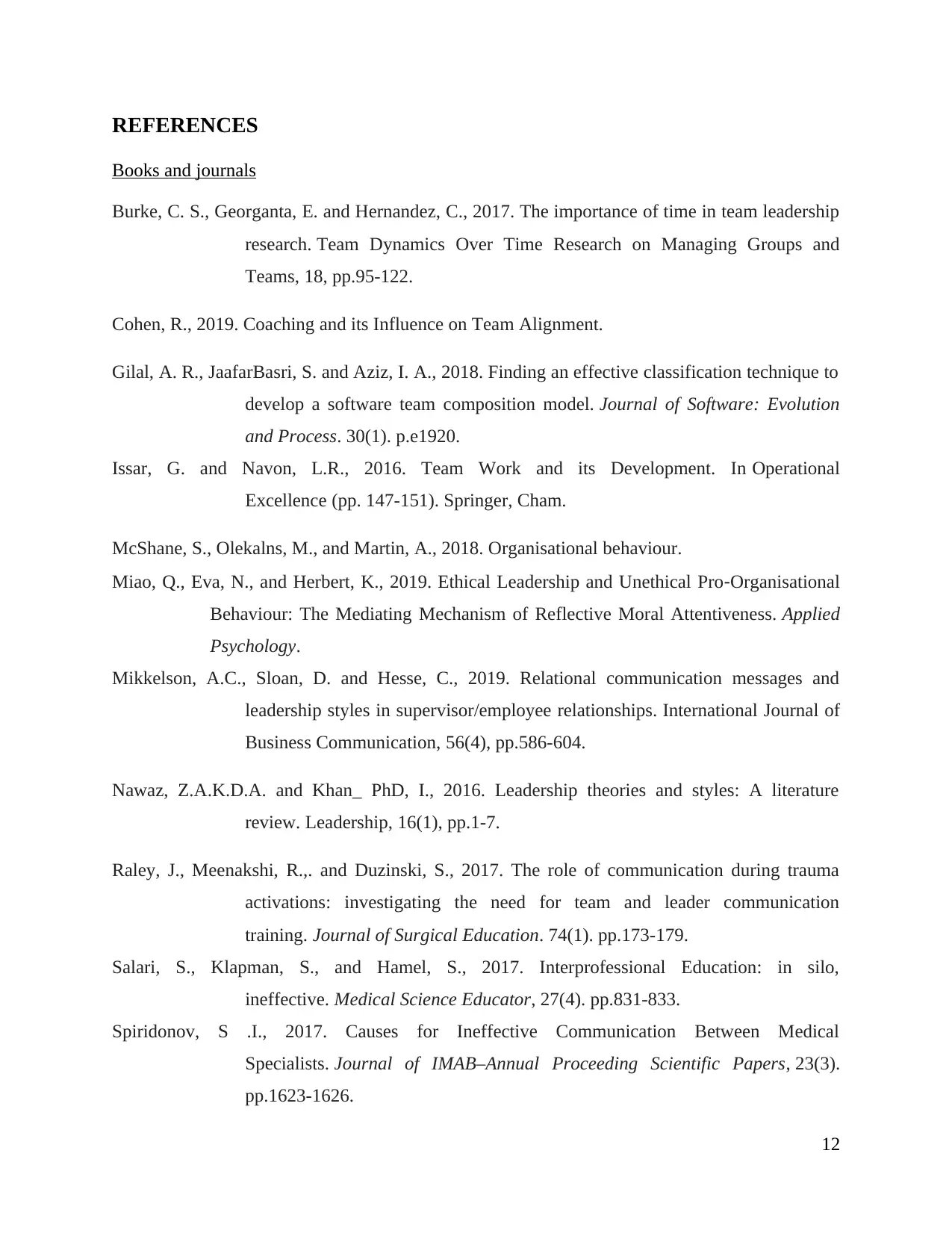
REFERENCES
Books and journals
Burke, C. S., Georganta, E. and Hernandez, C., 2017. The importance of time in team leadership
research. Team Dynamics Over Time Research on Managing Groups and
Teams, 18, pp.95-122.
Cohen, R., 2019. Coaching and its Influence on Team Alignment.
Gilal, A. R., JaafarBasri, S. and Aziz, I. A., 2018. Finding an effective classification technique to
develop a software team composition model. Journal of Software: Evolution
and Process. 30(1). p.e1920.
Issar, G. and Navon, L.R., 2016. Team Work and its Development. In Operational
Excellence (pp. 147-151). Springer, Cham.
McShane, S., Olekalns, M., and Martin, A., 2018. Organisational behaviour.
Miao, Q., Eva, N., and Herbert, K., 2019. Ethical Leadership and Unethical Pro‐Organisational
Behaviour: The Mediating Mechanism of Reflective Moral Attentiveness. Applied
Psychology.
Mikkelson, A.C., Sloan, D. and Hesse, C., 2019. Relational communication messages and
leadership styles in supervisor/employee relationships. International Journal of
Business Communication, 56(4), pp.586-604.
Nawaz, Z.A.K.D.A. and Khan_ PhD, I., 2016. Leadership theories and styles: A literature
review. Leadership, 16(1), pp.1-7.
Raley, J., Meenakshi, R.,. and Duzinski, S., 2017. The role of communication during trauma
activations: investigating the need for team and leader communication
training. Journal of Surgical Education. 74(1). pp.173-179.
Salari, S., Klapman, S., and Hamel, S., 2017. Interprofessional Education: in silo,
ineffective. Medical Science Educator, 27(4). pp.831-833.
Spiridonov, S .I., 2017. Causes for Ineffective Communication Between Medical
Specialists. Journal of IMAB–Annual Proceeding Scientific Papers, 23(3).
pp.1623-1626.
12
Books and journals
Burke, C. S., Georganta, E. and Hernandez, C., 2017. The importance of time in team leadership
research. Team Dynamics Over Time Research on Managing Groups and
Teams, 18, pp.95-122.
Cohen, R., 2019. Coaching and its Influence on Team Alignment.
Gilal, A. R., JaafarBasri, S. and Aziz, I. A., 2018. Finding an effective classification technique to
develop a software team composition model. Journal of Software: Evolution
and Process. 30(1). p.e1920.
Issar, G. and Navon, L.R., 2016. Team Work and its Development. In Operational
Excellence (pp. 147-151). Springer, Cham.
McShane, S., Olekalns, M., and Martin, A., 2018. Organisational behaviour.
Miao, Q., Eva, N., and Herbert, K., 2019. Ethical Leadership and Unethical Pro‐Organisational
Behaviour: The Mediating Mechanism of Reflective Moral Attentiveness. Applied
Psychology.
Mikkelson, A.C., Sloan, D. and Hesse, C., 2019. Relational communication messages and
leadership styles in supervisor/employee relationships. International Journal of
Business Communication, 56(4), pp.586-604.
Nawaz, Z.A.K.D.A. and Khan_ PhD, I., 2016. Leadership theories and styles: A literature
review. Leadership, 16(1), pp.1-7.
Raley, J., Meenakshi, R.,. and Duzinski, S., 2017. The role of communication during trauma
activations: investigating the need for team and leader communication
training. Journal of Surgical Education. 74(1). pp.173-179.
Salari, S., Klapman, S., and Hamel, S., 2017. Interprofessional Education: in silo,
ineffective. Medical Science Educator, 27(4). pp.831-833.
Spiridonov, S .I., 2017. Causes for Ineffective Communication Between Medical
Specialists. Journal of IMAB–Annual Proceeding Scientific Papers, 23(3).
pp.1623-1626.
12
⊘ This is a preview!⊘
Do you want full access?
Subscribe today to unlock all pages.

Trusted by 1+ million students worldwide
1 out of 13
Related Documents
Your All-in-One AI-Powered Toolkit for Academic Success.
+13062052269
info@desklib.com
Available 24*7 on WhatsApp / Email
![[object Object]](/_next/static/media/star-bottom.7253800d.svg)
Unlock your academic potential
Copyright © 2020–2025 A2Z Services. All Rights Reserved. Developed and managed by ZUCOL.





